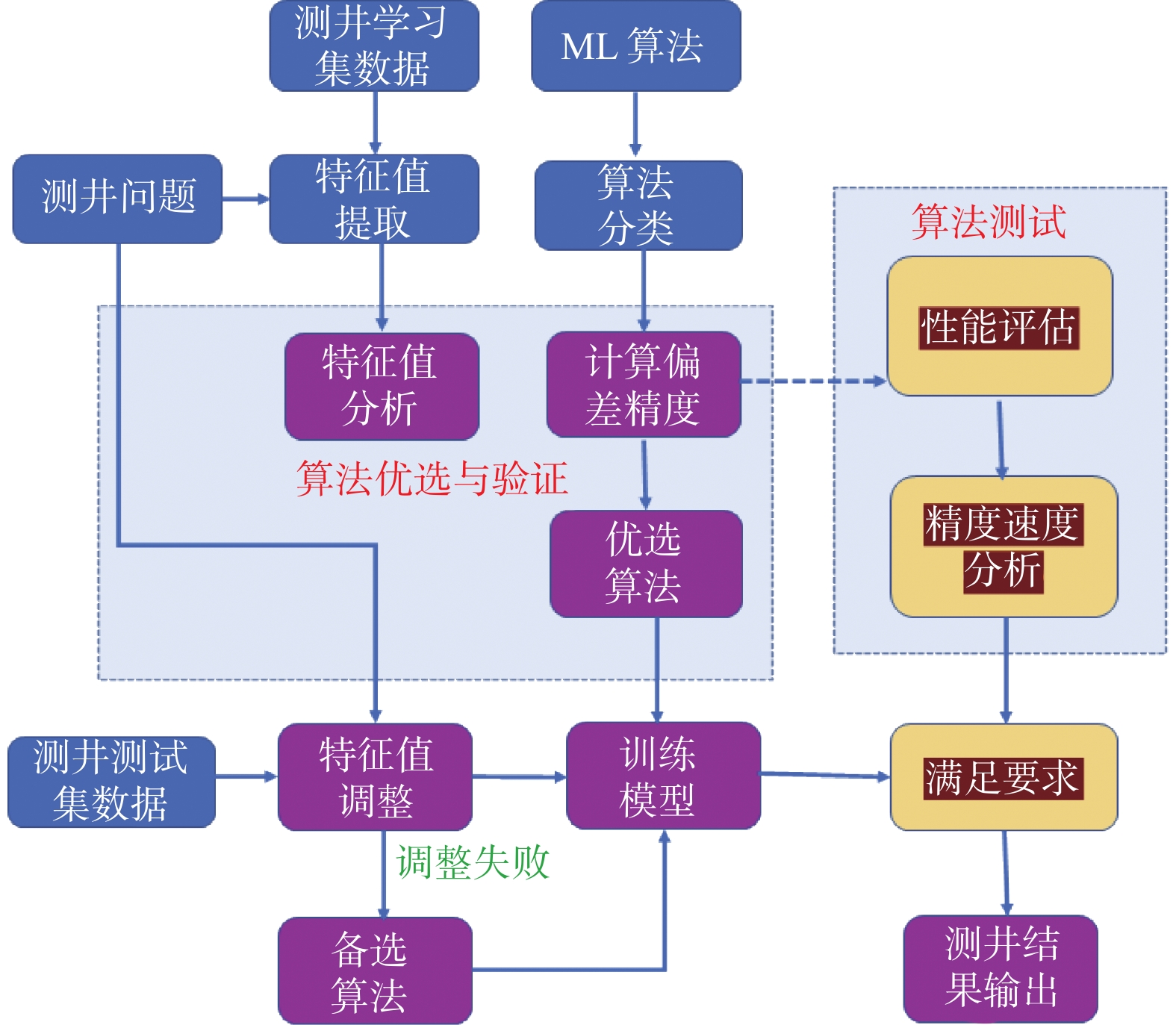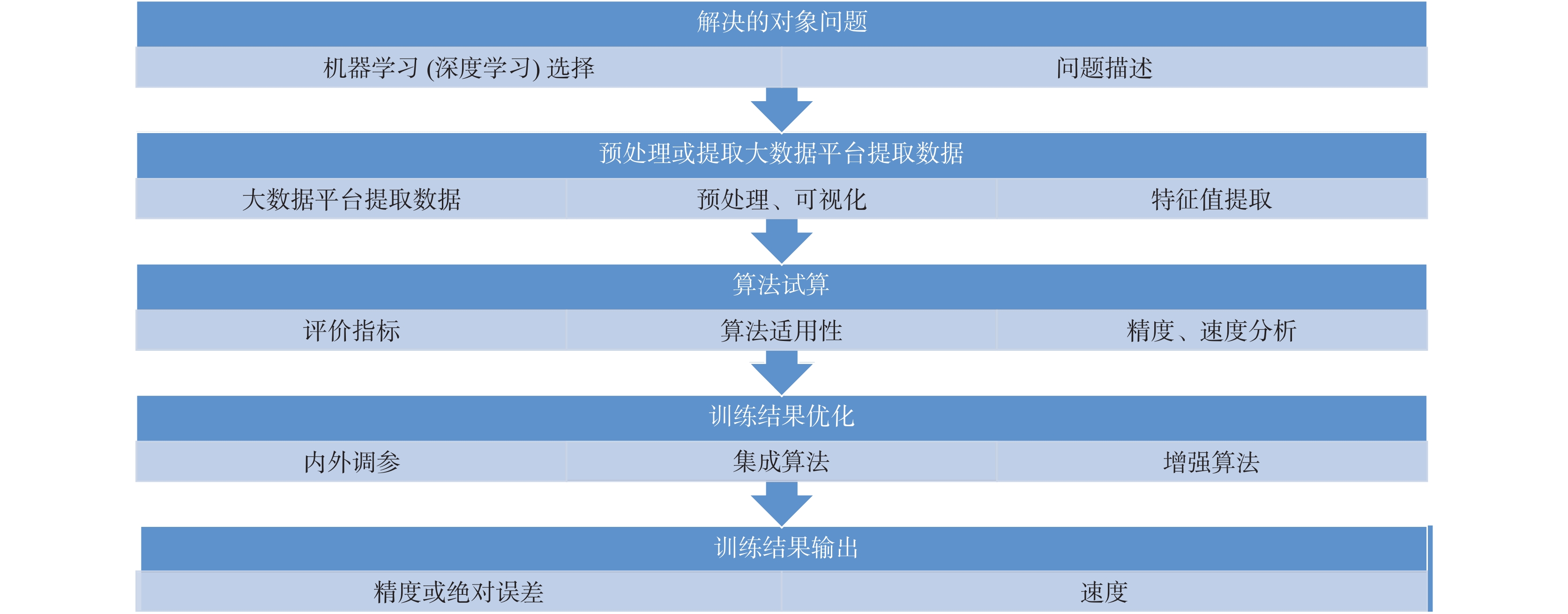Applicability and Application of Machine Learning Algorithm in Logging Interpretation
-
摘要:
机器学习,特别是深度神经网络学习算法的发展,正在改变人们发现知识的方式。目前油气工业正在向转向非常规和深海的油气勘探和开发。基于有限岩石物理参数建立的评价解释模型难以满足反映非常规储层复杂的岩性和结构,这使传统测井评价技术受到了很大的挑战。以油气大数据为基础、机器学习算法为核心、油气大数据云计算为动力以及油气应用场景为源泉的油气人工智能(Oil & Gas AI)极大地改变传统的油气工业各个领域。笔者以地球物理测井为研究对象,依据数据驱动的地球物理知识发现原理和机器学习属性,按照“数据–算法–平台–知识–应用场景”研究思路,开展机器学习算法在测井技术中的适用性研究。对机器算法的内在特性、原理、质量控制、硬件要求,学习模型选择、测试以及性能评价实现过程进行分析。笔者梳理和总结了机器学习算法在测井中适用性的树状图,尤其是在油气测井的方法研究、数据处理以及地层评价中的应用潜力与机器学习算法对应关系,其中包括数据校正的模拟方法、数据标定的岩石物理分析、测井数据质量控制、综合评价以及油藏评价监测。研究表明,机器学习算法在岩性识别与储层分类、力学评价、以及油藏评价等方面应用有明显的优势,贯穿于测井方法、仪器设计、测井作业及测井解释中。机器学习算法相对于传统的岩石物理建模方法,以数据为纽带综合评价岩石物理的多重属性。这从数据科学角度突破了实验条件和物理属性的限制,具有跨学科、综合性的特点。
Abstract:Machine learning, especially the development of deep neural network learning algorithms, is changing the way people discover knowledge. As the oil and gas industry is shifting to unconventional oil and gas exploration and development, the evaluation and interpretation model based on limited petrophysical parameters is difficult to meet the complex lithology and structure of unconventional reservoirs, which poses a great challenge to the traditional logging evaluation technology. Oil & gas artificial Intelligence (Oil & Gas AI), based on oil and gas big data, machine learning algorithms, oil and gas application scenarios, has greatly promoted the application and development of AI technology in various professionals of oil and gas industry. According to the data–driven petrophyical knowledge discovery, and the research idea of the “data–algorithm–platform–knowledge–application scenario”, firstly we analyzed the inherent attributes, principles, quality control, hardware requirements, learning model selection, testing, and performance evaluation implementation process for the machine learning algorithm. The tree graph of the applicability of the machine learning algorithm in logging is summarized, especially the relationship between the application potential and machine learning algorithm in oil and gas logging. These applications include simulation methods for data correction, petrophysical analysis for data calibration, logging data quality control, integrated evaluation, and reservoir monitoring. The study case shows that machine learning algorithms in lithology identification and reservoir evaluation, classification, mechanics, and reservoir evaluation based on the data link across multiple physical properties of petrophysics compared with traditional well logging method, which break through the limitation of experimental conditions and physical properties and has interdisciplinary and comprehensive characterization, had obvious advantages and potentials in well logging technology.
-

-
表 1 机器学习算法在测井中的应用统计表
Table 1. Machine learning for logging applications
解决问题 实现手段 优势 效果 复杂岩性识别,岩性曲线有限 集成学习算法 突破传统岩性曲线多解性限制 识别多种矿物成份致密砂岩,碳酸盐岩 电测井仪器、核测井仪器正演模拟算法慢 回归算法、深度神经网络 通过已有的模拟数据,学习出未知的模拟数据 快速实现仪器仿真设计、为测井仪器数字孪生奠定基础 井眼、层厚以及围岩影响校正 回归算法、卷积神经网络 实现同时校正 确定地层的声电核真参数 岩心测试预测,岩心电镜图片特征提取 卷积神经网络建模、学习 岩石物理参数预测、扫描电镜图像特征提取 孔隙度、渗透率、孔隙类型与矿物结晶识别 测井曲线异常 相关分析 声电核测井曲线特征对比分析 消除仪器或测量引起的误差,提高测井解释符合率 多矿物复杂岩性识别 分类方法 岩心、录井、钻井、测井数据学习 页岩油气储层,复杂碳酸盐岩储层 横波数据提取和修复 回归算法 多测井曲线、岩心测试数据学习 页岩油气储层力学参数评价、压裂效果评价 孔隙度、渗透率、饱和度模型 人工神经网络 泥质,黏土矿物导电性,束缚水饱和度参数学习 四性参数,真参数求取 多井归一化,多参数提取 聚类算法,降维算法 多井多学科参数学习 多井储层厚度、孔隙度、饱和度提取 页岩油气压裂力学评价、寿命预测、复杂岩性识别 集成机器学习、循环深度神经网络 多学科参数学习、动态监测数据学习 弹性模量、剪切模量、泊松比参数提取,产能预测 表 2 机器学习算法特点及测井适用性统计表
Table 2. Characterization of machine learning and its applicability on well logging
算法 原理 优势与不足 测井适用性 线性回归 在一元的情况下拟合出一条直线,多元时为平面或者曲面,反映数据样本的分类或回归值 速度快、成本低、对于连续线性数据具有可解释性。适合小、中型数据 测井数据修复、测井数据归一化 决策树 决策树是一个由根到叶的递归过程,在每一个中间结点寻找划分属性。若当前结点包含的样本属于同一类别,无需再分支 速度快、结果易于解释、对局部变量敏感。精度有限、误差累积快、不适合于大数据预测 岩性划分、含油性评价、储层质量与分类 随机森林 随机森林就是通过集成的思想将多棵树集成学习的方法,其基本单元为决策树 精度高、适用于高维大数据预测、对数据缺失不敏感。消耗资源大,易出现过拟合 测井沉积相分类、储层分类、含油性评价 朴素贝叶斯法 贝叶斯推理是统计学和机器学习中的一个框架,它使用观察证据来更新假设为真的概率。其关注数据处理和模型的不确定性、编码先验信念和估计错误传播 原理简单,速度快,不受数据噪声和数据缺失影响。有限精度,具有独立的预测器,不适应于大数据。 岩性、岩相划分、含油性评价、储层质量分类、测井沉积相 邻近法 一个样本的属性与数据集中的k个样本的属性最相似,如果这k个样本中的属于某一个类别, 则该样本也属于这个类别 非线性。用于中、大型数据 常规测井横波提取、含油性评价、储层质量分类 集成学习算法 包含引导聚合和提升算法。引导聚合是通过对样本训练集合进行随机化抽样,反复抽样训练新的模型。提升算法通过不断地使用一个弱学习器弥补前一个弱学习器不足的过程,实现目标函数值误差小 原理简单、精度高、调节参数少。消耗资源大,适合中小数据量,可解释性差 沉积相与储层分类、岩性划分、数据标准化与修复、深度匹配 主成分分析 利用正交变换把由线性相关变量表示的训练数据转换为少数几个由线性无关变量表示的数据,线性无关的变量称为主成分 中大型数据,针对专业人员 油藏管理监测、历史数据分析、测井知识发现、岩石力学参数、特征值提取 卷积神经网络 卷积滤波器本质上是使用滑动窗口方法的加权向量/矩阵/立方体。根据内核结构,卷积增强了数据的某些特征,例边缘、趋势或平坦区域。卷积是嵌入在神经元水平的卷积神经网络中的,它从之前的层中提取有用的特征 适合于大中型数据。硬件资源要求高 裂缝识别、压裂评价、沉积环境分析 循环神经网络 递归神经网络的信息可以在不同节点之间循环,产生诸如存储器之类的复杂动态 适合于大中型数据。硬件资源要求高 油藏监测、微地震监测、压裂效果评价 长短记忆法 LSTM是使用当前输入和上一个状态传递下来信息,训练得到四个状态。由状态向量乘以权重矩阵之后,再通过激活函数转换成0到1之间的数值,作为一种门控状态。而输入数据通过激活函数将转换成-1到1之间的值 适合于大中型数据。硬件资源要求高 油藏监测、微地震监测、压裂效果评价 深度强化学习 人工智能是一种算法吸收信息来执行具有人类智能特征的任务的能力,例如识别物体和声音、将语言上下文化、从环境中学习和解决问题 适合于大中型数据。硬件资源要求高、数据资源丰富 自主测井、虚拟测井 对抗神经网络 这是一系列无监督机器学习方法,用未知概率密度函数生成样本。生成对抗网络是能区分真实样本和虚假样本的鉴别器网络 计算限制、主观特征选择 学习测井专家知识、智能仪器、数据质量 表 3 多种测井曲线下的机器学习算法储层分类结果对比表
Table 3. The comparison of machine learning reservoir classification results under multiple logging curves
组(ML算法) 决策树 K邻近法 使能法 深度神经网络 特征曲线数 1 63.8 69.7 89.4 94.6 Pe、Cal、GR、SP、ML、DEN、DT、PHIN 2 66.1 78.6 85.5 93.2 Pe、Cal、GR、SP、ML、DEN 3 61.6 66.7 78.9 91.8 Pe、Cal、GR、SP、ML 4 58.6 64.6 76.7 90.9 Pe、Cal、GR 5 55.9 60.5 72.1 85.4 Pe、Cal -
[1] 程希, 程宇雪, 程佳豪, 等. 基于机器学习与大数据技术的地球物理测井系统[J]. 西安石油大学学报(自然科学版), 2019, 06: 108-116
CHENG Xi, CHENG Yuxue, CHENG Jiahao, et al. Geophysical logging system based on machine learning and big data technology[J]. Journal of Xi'an Shiyou University ( Natural Science Edition) , 2019, 34( 6) : 108-116.
[2] 程希, 宋新爱, 李国军, 等. 数据模型与物理模拟驱动的人工智能测井[J]. 测井技术, 2021, 45(03): 233-329 doi: 10.16489/j.issn.1004-1338.2021.03.002
CHENG Xi, SONG Xin’ai, LI Guojun, et al. Artificial intelligence logging driven by data modeling and physical simulation[J]. Logging Technology, 2021, 45(03): 233-329. doi: 10.16489/j.issn.1004-1338.2021.03.002
[3] 杜金虎, 时付更, 杨剑锋, 等. 中国石油上游业务信息化建设总体蓝图[J]. 中国石油勘探, 2020, 25 (5): 1-8 doi: 10.3969/j.issn.1672-7703.2020.05.001
DU Jinhu, SHI Fuqing, YANG Jianfeng, et al. A general blueprint for upstream business information construction in China[J]. China Petroleum Exploration, 2020, 25 (5): 1-8. doi: 10.3969/j.issn.1672-7703.2020.05.001
[4] 韩海辉, 李健强, 易欢, 等. 遥感技术在西北地质调查中的应用及展望[J]. 西北地质, 2022, 55(3): 155-169. doi: 10.19751/j.cnki.61-1149/p.2022.03.012
HAN Haihui, LI Jianqiang, YI Huan, et al. Application and Prospect of Remote Sensing Technology in Geological Survey of Northwest China[J]. Northwestern Geology, 2022, 55(3): 155-169 doi: 10.19751/j.cnki.61-1149/p.2022.03.012
[5] 刘梁, 石卫, 张晓平, 等. 基于高斯混合聚类算法的西安市人工填土空间分布研究[J]. 西北地质, 2022, 55(2): 298-304 doi: 10.19751/j.cnki.61-1149/p.2022.02.027
LIU Liang, SHI Wei, ZHANG Xiaoping, et al. Research on Spatial Distribution of Artificial Fill in Xi’an Based on Gaussian Mixture Clustering Algorithm[J]. Northwestern Geology, 2022, 55(2): 298-304 doi: 10.19751/j.cnki.61-1149/p.2022.02.027
[6] 李宁, 徐彬森, 武宏亮, 等. 人工智能在测井地层评价中的应用现状及前景[J]. 石油学报, 2021, 42(4): 508-522 doi: 10.1038/s41401-020-0474-7
LI Ning, XU Binsen, WU Hongliang, et al. Application status and prospects of artificialintelligence in well logging and formation evaluation[J]. Acta Petrolei Sinica, 2021, 42( 4): 508-522. doi: 10.1038/s41401-020-0474-7
[7] 李志忠, 卫征, 陈霄燕, 等. 新型对地观测技术与地球健康体检[J]. 西北地质, 2022, 55(2): 56-70.
LI Zhizhong, WEI Zheng, CHEN Xiaoyan, et al. New Earth Observation Technology and Earth Health Examination[J]. Northwestern Geology, 2022, 55(2): 56−70.
[8] 罗刚, 肖立志, 史燕青, 等. 基于机器学习的致密储层流体识别方法研究[J]. 石油科学通报, 2022, 7(01): 24-33 doi: 10.3969/j.issn.2096-1693.2022.01.003
LUO Gang, XIAO Lizhi, SHI Yanqing, et al. Machine learning for reservoir fluid identification with logs. Petroleum Science Bulletin, 2022, 01: 24-33. doi:10.3969/j.issn.2096-1693.2022.01.003
[9] 匡立春, 刘合, 任义丽, 等. 人工智能在石油勘探开发领域的应用现状与发展趋势[J]. 石油勘探与开发, 2021, 48 (1): 1-11 doi: 10.11698/PED.2021.01.01
KUANG Lichun, LIU He, REN Yili, et al. Application and development trend of artificial intelligence in petroleum exploration and development [J]. Petroleum Exploration and Development, 2021, 48(1): 1-11. doi: 10.11698/PED.2021.01.01
[10] 赵丽莎, 史永彬, 金玮, 等. 基于梦想云的测井智能化解释应用研究[J]. 中国石油勘探, 2020, 25(5): 97-103 doi: 10.3969/j.issn.1672-7703.2020.05.013
ZHAO Lisa, SHI Yongbin, JIN Wei, et al. Research on the application of intelligent interpretation of logging based on dream cloud[J]. China Petroleum Exploration, 2020, 25(5): 97-103. doi: 10.3969/j.issn.1672-7703.2020.05.013
[11] 邹文波. 人工智能研究现状及其在测井领域的应用[J]. 测井技术, 2020, 44(04): 323-328 doi: 10.16489/j.issn.1004-1338.2020.04.001
ZOU Wenbo. Current status of artificial intelligence research and its application in the field of well logging[J]. Logging Technology, 2020, 44(04): 323-328. doi: 10.16489/j.issn.1004-1338.2020.04.001
[12] Akkurt R, Miller M, Hodenfield B, et al. . Machine Learning for Well Log Normalization[C]. Society of Petroleum Engineers, 2019.
[13] Gupta I, Devegowda D, Jayaram V, et al. Machine Learning Regressors and their Metrics to Predict Synthetic Sonic and Brittle Zones [C]. Unconventional Resources Technology Conference, 2019
[14] Karianne J, Paul A, Maarten V, et al. Machine learning for data-driven discovery in solid Earth geoscience[J]. Science, 2019, 363(6433): 1299.
[15] Kuvichko A, Spesivtsev P, Zyuzin V, et al. Field-Scale Automatic Facies Classification Using Machine Learning Algorithms[C]. Society of Petroleum Engineers, 2019.
[16] Markus R, Gustau C, Bjorn S, et al. Deep learning and process understanding for data-driven Earth system science[J]. Nature, 2019, 556(7743): 195-204.
[17] Oruganti Y D, Yuan P, Inanc F, et al. Role of Machine Learning in Building Models for Gas Saturation Prediction[C]. Society of Petrophysicists and Well-Log Analysts, 2019.
[18] Xu C, Misra S, Srinivasan P, Ma S. When Petrophysics Meets Big Data: What can Machine Do? [C]. Society of Petroleum Engineers, 2019.
[19] Wu H H, Pan L, Ma J, et al. Enhanced Reservoir Geosteering and Geomapping from Refined Models of Ultra-Deep LWD Resistivity Inversions Using Machine-Learning Algorithms[C]. Society of Petrophysicists and Well-Log Analysts, 2019.
-




 下载:
下载:






